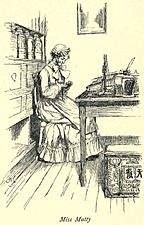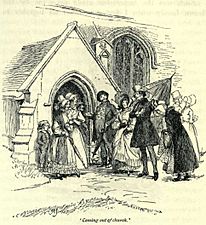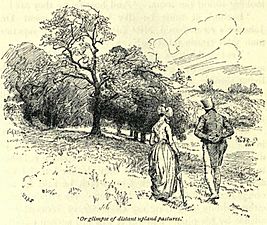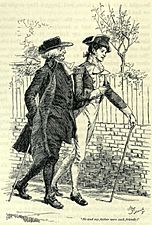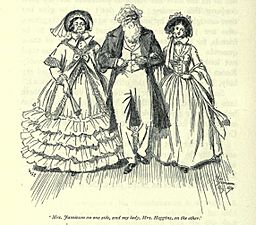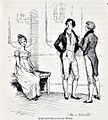Hugh Thomson facts for kids
Quick facts for kids
Hugh Thomson
|
|
|---|---|
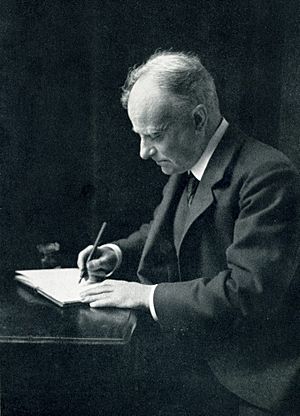
Thomson at his desk, 1912
|
|
| Born | 1 June 1860 |
| Died | 7 May 1920 (aged 59) |
| Movement | Cranford School |
Hugh Thomson (born June 1, 1860, died May 7, 1920) was a famous Irish illustrator. He was born in Coleraine, near Derry. He is most famous for his detailed pen-and-ink drawings. These drawings brought to life the stories of well-known authors like Jane Austen, Charles Dickens, and J. M. Barrie.
Thomson also started a special style of art called the Cranford School of illustration. This happened when he illustrated the 1891 edition of Mrs. Gaskell's book, Cranford.
Contents
About Hugh Thomson's Life
Hugh Thomson was the oldest of three children. His father, John Thomson, was a tea merchant, and his mother, Catherine Andrews, owned a shop. Even though he never had formal art lessons, Hugh loved to draw. As a boy, he filled his schoolbooks with pictures of horses, dogs, and ships.
He went to Coleraine Model School. When he was 14, he left school to work as a clerk for a linen company. A few years later, his amazing art skills were noticed. In 1877, he got a job at a printing and publishing company called Marcus Ward & Co.
Family Life and Moving to London
On December 29, 1884, Hugh Thomson married Jessie Naismith Miller in Belfast. Soon after, they moved to London so Hugh could focus on his art career. They had one son named John, who was born in 1886.
In 1911, the family moved to Sidcup. They hoped the move would help their health, which was often delicate. Hugh missed being close to the National Gallery and other museums in London. These places were important for his research when he created illustrations.
Challenges During World War I
During World War I, people bought fewer of Thomson's illustrations. He mostly worked on a few propaganda pamphlets and drawings for friends. By 1917, Hugh was having money problems. He had to take a job with the Board of Trade, where he worked until 1919.
Hugh Thomson passed away from heart disease at his home in Wandsworth Common on May 7, 1920.
Hugh Thomson's Art Career
When he was 17, Thomson joined the art team at Marcus Ward & Co. There, he learned a lot from John Vinycomb, who was the head of the art department. Vinycomb and Thomson's cousin, Mrs. William H. Dodd, really helped him grow as an artist early in his career.
In 1883, Thomson moved to London to follow his artistic dreams. He became a key artist for The English Illustrated Magazine. He first worked with Randolph Caldecott on the 1885–86 issue. Later, he teamed up with Herbert Railton for the 1887–88 issue. His style at this time was very similar to Caldecott's.
Illustrating Books for Famous Authors
Thomson also became very popular for his book illustrations. Many young artists looked up to him. He famously illustrated books by William Shakespeare, Jane Austen, and Charles Dickens.
His drawings for Elizabeth Gaskell's book Cranford (published in 1891) were a huge hit. They inspired other publishers to create similar "gift books." These books were often bound in dark green cloth with gold designs. Between 1886 and 1900, he illustrated many small classic books for Macmillans and Kegan Paul.
Much of his work during this time involved creating beautiful gift books and new editions of popular classics. Thomson's most loved illustrations showed "fine line drawing of rural characters and gentle countrified society."
Art Exhibitions
Thomson's artwork was shown in many exhibitions during his lifetime. This included a show in 1899 at the Birmingham and Midland Institute. In 1910, his watercolor drawings for Shakespeare's The Merry Wives of Windsor were displayed at The Leicester Galleries in London. His illustrations were also part of an exhibition in 1891 with another famous illustrator, Kate Greenaway, at the Fine Art Society.
How Thomson Created His Art
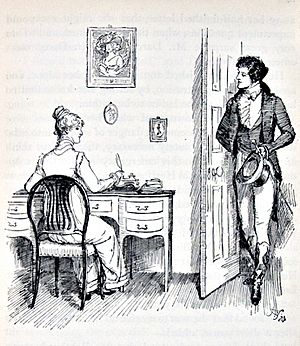
Thomson is best known for his pen-and-ink drawings. For most of his career, he worked in black and white. However, he sometimes added color to his pieces for exhibitions. The first time he did this was in 1899 for the Birmingham and Midland Institute exhibition. There, he colored his Cranford illustrations, which he had drawn eight years earlier.
Throughout his career, Thomson experimented with watercolors. But he only used color in his illustrations when his publishers asked for it. His first book illustrations that were fully prepared and printed in color were for the last two books in the Cranford series: Scenes of Clerical Life (1906) and Silas Marner (1907).
When starting a new illustration, Thomson would research his subject carefully. He often visited the British Museum and the Victoria and Albert Museum. He would take detailed notes on things like costumes, furniture, old prints, and building designs. His sketchbooks show how much attention he paid to details. For example, he drew pages showing how ladies' bonnets changed over time. He also drew how a cavalry officer would hold the reins of his horse.
Thomson was often praised for his ability to "project himself into a story." This means he could really understand and feel the story he was illustrating. Many of his drawings are now strongly linked to the books they appear in. This is true for his illustrations for Pride and Prejudice and other Jane Austen novels.
When J. M. Barrie's play Quality Street was published with Thomson's illustrations in 1913, an art critic said, "The Barrie-Thomson combination is as perfect in its way as that of Gilbert and Sullivan."
Thomson was elected as a member of the Royal Society of Painters in Water Colours (RI) in 1897. He retired from this role in 1907.
The Cranford School of Illustration
Hugh Thomson was the first artist of the Cranford School of illustrators. This group moved away from the popular style of Aubrey Beardsley in the 1890s. Instead, they focused on a more delicate style, inspired by the 18th century.
The 'Cranford School' wasn't a formal school where artists trained together. It was more about a shared style of art. This style celebrated a sweet, old-fashioned idea of 'old England' before factories and machines changed everything. The style got its name from Thomson's illustrations for the Macmillan edition of Mrs. Gaskell's book Cranford. Cranford was the first of 24 books in a series, and Thomson illustrated 11 of them.
This style was "nostalgic, affectionate and slightly whimsical." It looked back fondly at historical themes. The artists in this school were all inspired by the literature, art, clothes, or general feeling of England in the 1700s. They became very good at creating a sense of nostalgia. Their style focused on recreating a "by-gone golden era" before industrialization.
The Cranford School style became possible because of new printing methods. Photo-mechanical reproduction allowed the fine pen lines that were special to this style to be printed clearly. This was not possible with older wood engraving techniques.
Thomson started this art movement. Other artists who were part of the Cranford School included:
- C. E. Brock (1870–1938)
- H. M. Brock (1875–1960)
- Christiana Mary Demain Hammond (1860–1900), who signed her work Chris Hammond.
- Fred Pegram (1870–1937)
- F. H. Townsend (1868–1920)
Illustrations from Cranford
The pictures below are some of Thomson's illustrations for the 1891 Macmillan edition of Cranford. This book was very important because it started the Cranford School style. The book has 111 illustrations in total.
Selected Works by Hugh Thomson
Hugh Thomson illustrated 65 books in total. He also created many drawings for magazines and other publications. Here is a list of some of his well-known works. You can find digital copies of many of these online.
- Illustrations in The English Illustrated Magazine (starting in 1885–86)
- Days with Sir Roger De Coverley (1886) digital copy
- Coaching Days and Coaching Ways (1888) digital copy
- Cranford (1891) digital copy
- The Vicar of Wakefield (1891) digital copy
- The Ballad of Beau Brocade (1892) digital copy
- Our Village (1893) digital copy
- Pride and Prejudice (1894) digital copy
- The Story of Rosina and other Verses (1895) digital copy
- Emma (1896) digital copy
- Sense and Sensibility (1896) digital copy
- Mansfield Park (1897) digital copy
- Northanger Abbey (1898) digital copy
- Persuasion (1898) digital copy
- The Illustrated Fairy Books (1898)
- Illustrations for twelve books in the Highways and Byways series, including Donegal and Antrim (1899) digital copy
- Peg Woffington (1899) digital copy
- A Kentucky Cardinal (1901) digital copy
- The History of Henry Esmond (1905) digital copy
- Illustrations for eleven of the twenty-four books in the Cranford series (gift books), including Evelina (1903) digital copy, Scenes of Clerical Life (1906) digital copy, and Silas Marner (1907) digital copy
- As You Like It (1909) digital copy, digital copy
- The Merry Wives of Windsor digital copy
- Quality Street (1913) digital copy
- Tom Brown's Schooldays (1918) digital copy
- An Irish Horse Fair
Gallery


